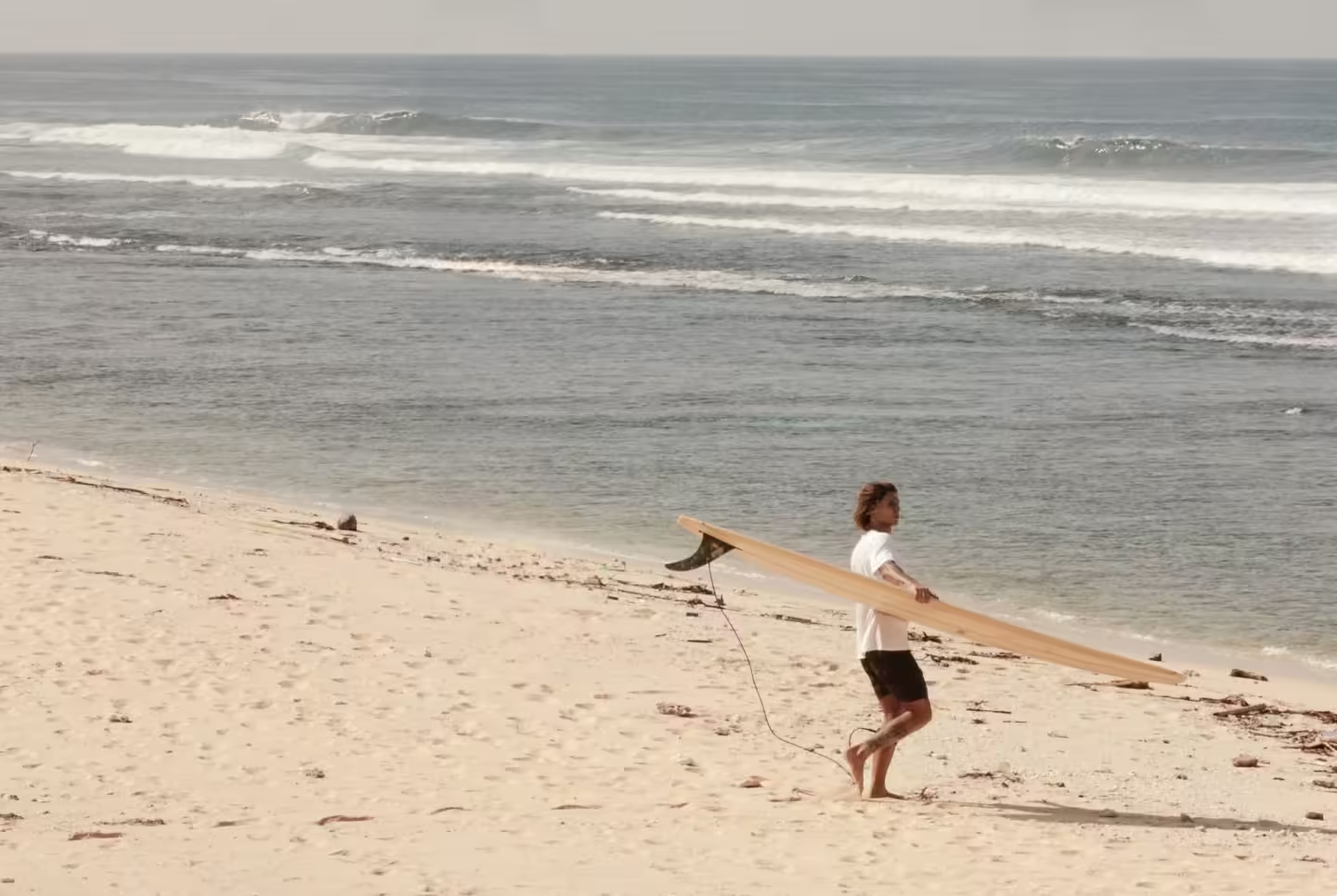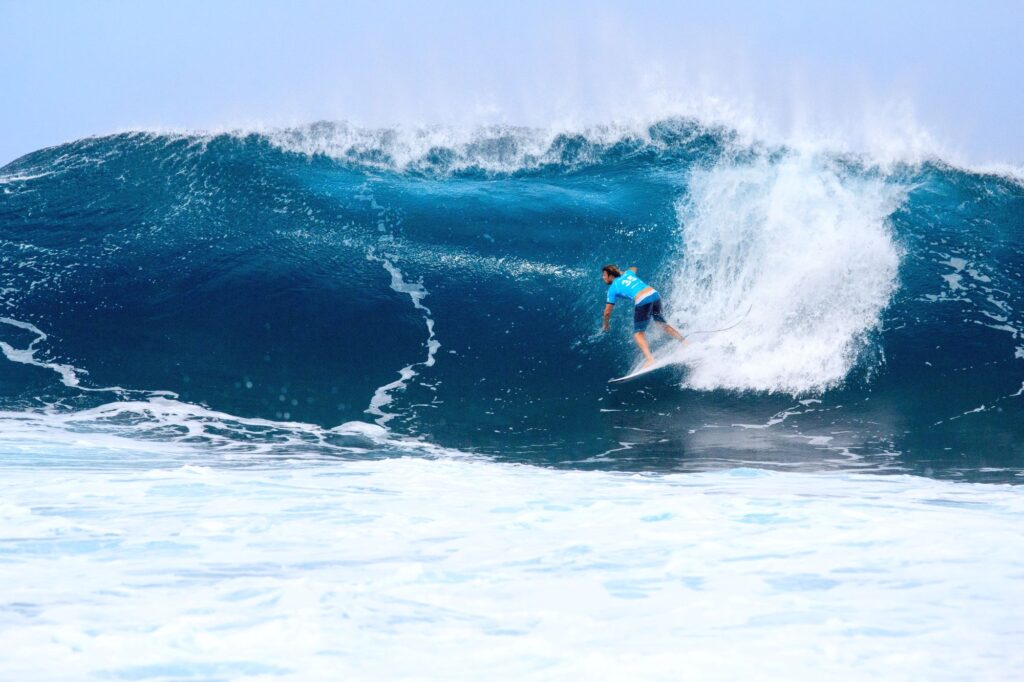How Fast Do Surfers Go?
Surfing is an exhilarating activity that can provide a wide range of experiences, from the peaceful tranquility of paddling out and catching a mellow wave to the adrenaline rush of charging down the face of a giant swell at breakneck speeds.
But just how fast can surfers actually go? From barreling waves to big wave surfing, surfers can reach impressive speeds while riding the waves.
In this post, we’ll explore the different factors that contribute to a surfer’s speed, including wave height, board design, and the surfer’s own skill level.
Complete your surfer look and elevate your style with unique masterpieces.
Surfcasual offers the ultimate collection of comfy surfer’s t-shirts that perfectly blend class and stoke.
Explore our exclusive collection here.
Surfer’s Average Speed Is Higher Than You Might Imagine
When riding massive waves, surfers can achieve speeds of up to 40 to 50 miles per hour.
Furthermore, on an average 4-7 feet wave, surfers usually hit speeds ranging from 10 to 15 miles per hour.
As the waves grow larger than 7 feet, surfers can reach speeds of around 20 miles per hour.
The size and shape of the wave play a crucial role in determining how fast surfers can go. A steeper, more powerful wave will allow surfers to reach higher speeds than a slower, mushy wave.
The angle at which the wave is breaking also affects speed, with waves that break more vertically allowing for higher speeds than those that break more horizontally.
But before we break it down even further, as surfing is perceived as a carefree relaxing activity, surfers need speed to ride the waves.
Why Do Surfers Need Speed?
Speed is crucial to surfing as it allows surfers to catch waves. When a surfer is paddling to catch a wave, they need to generate enough speed to match the speed of the wave.
If they don’t generate enough speed, they will miss the wave, and all their effort in paddling will be for nothing.
In addition, speed is essential for surfing maneuvers. The faster a surfer goes, the easier it is to perform aerials, cutbacks, and other tricks that require momentum.
Finally, speed allows surfers to stay ahead of the breaking part of the wave, which is essential for longer rides and more challenging waves.
Factors That Creates The Waves’ Speed
The speed of a wave is determined by the depth of the water, the shape of the wave, and the wind speed. Waves travel faster in deeper water, where there is less friction with the ocean floor.
In shallow water, waves slow down and increase in height as the bottom of the wave begins to drag on the ocean floor.
This effect is why waves begin to break as they approach the shore, where the water is shallower.
The shape of the wave also plays a role in determining its speed. A wave with a long, smooth shape will travel faster than a wave that is short and choppy.
The smoother wave shape experiences less resistance as it travels through the water, allowing it to maintain its speed.
In contrast, a shorter and choppier wave will slow down more quickly as it moves through the water.
Finally, wind speed also plays a significant role in determining wave speed. The energy from the wind is transferred to the water, causing the waves to form and travel across the ocean’s surface.
The stronger the wind, the more energy is transferred to the water, and the larger and faster the waves will become.
So the deeper the water, the faster the wind, and the smoother the wave, the higher speeds a surfer can reach, and this is a phenomenon you will most probably see in big waves surf spots.
How Fast Do Surfers Go at Big Waves Surf Spots?
The monstrous waves of Nazaré, the eyes opening view of Pipeline, and the jaw dropping feeling of Jaws are so fascinating that it might make you wonder how fast surfers go at these unique surf spots.
Rest assured, we have the answers.
Nazaré, Portugal
Situated north of the capital city Lisbon, Nazaré in Portugal is renowned for having the world’s largest tides.
Due to these immense waves, the region has become a popular destination for adventurous surfers from all over the world.
Riding the enormous waves at Nazaré’s North Beach, surfers can reach speeds exceeding 80 miles per hour, while the waves themselves can tower above 70 feet.
Nonetheless, the speed range for these waves typically falls between 60-80 miles per hour.
German surfer, Sebastian Steudtner holds the world record for the biggest wave ever surfed.
Despite suffering from vertigo, which could be challenging when confronting a 90 feet drop, Steudtner successfully rode 86 feet(!) wave on a cold winter day at Nazaré and now holds the Guinness World Record. Amazing.
Jaws, Hawaii
Jaws is another famous surfing location renowned for its massive waves. Peahi, commonly referred to as Jaws, is widely recognized as Maui’s most notorious surf spot, with wave heights ranging between 30 to 80 feet.
This surf zone is characterized by rapidly changing conditions, where slight variations in swell size and direction can turn the area from a serene surf destination to a treacherous arena in no time.
Due to the sheer size of the waves here, surfers have been able to reach speeds over 50 miles per hour. That’s darn fast.
Pipeline, Hawaii
Pipeline is considered one of the best places to surf in the world. It has consistently large waves ranging from 8-20 feet that break close to shore.
With such great conditions, it’s not uncommon for experienced surfers at Pipeline to reach speeds of 30 to 40 miles per hour or higher.
Final Thoughts
The need for speed is an essential part of surfing culture and surfing ain’t just about catching some gnarly waves, it’s also about chasing that elusive adrenaline rush that comes with riding at breakneck speeds.
Surfing the waves at Jaws and Pipeline can give you a rush of speed and excitement like nothing else.
And if you’re a real pro athlete, head over to Nazaré and see if you can catch a wave on one of the largest and fastest waves ever recorded.
It’s also very reasonable to stay near the red lighthouse and just watch the monstrous waves the ocean has to offer.
So next time you see a surfer flying down the face of a wave at lightning speed, you will know what are they chasing, or gliding from.



